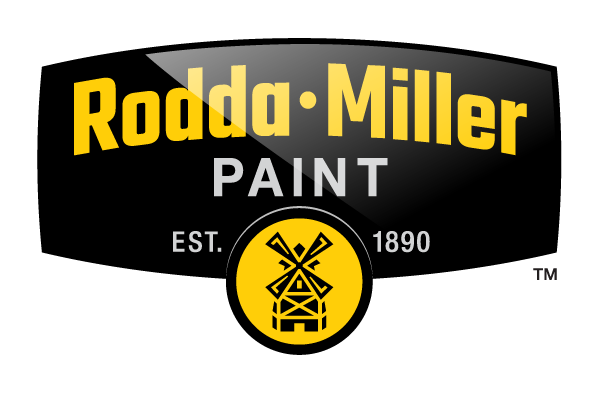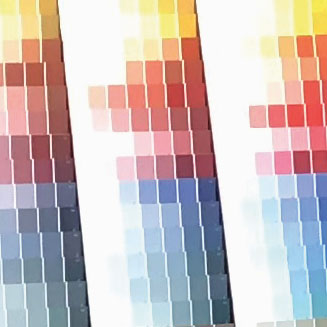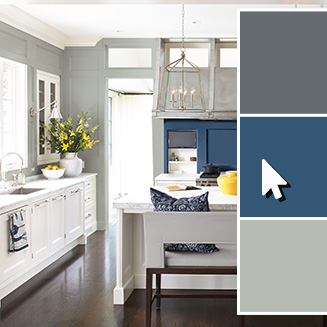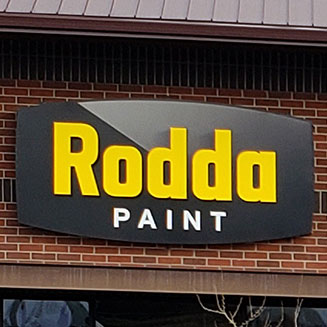STEP 1 – Choose the Right Paint
While any paint can give a space a quick facelift, a premium paint will transform your space with a lasting finish. Our Premium paints impart a smoother, more uniform appearance and finish with much better coverage than any economy paint. A house is a major investment and our Premium paints will provide it with the long-term protection it deserves.
PAINT FINISHES / GLOSS LEVEL
Paints have been around for a long time and each paint company describes their paint finishes differently. One paint company may describe their paint finish by calling it Eggshell, while another paint company may describe the same paint finish as Satin. Or, Pearl may be the finish name used by one company, while another company chooses to call the same finish Low Gloss or even something different.While the descriptive name of the particular paint finish/GLOSS Level is unique from company to company, it is governed by a performance standard used around the globe and is identified by one of 7 Gloss Levels.
- Flat paints are a good choice for adult bedrooms, living or dining rooms, and ceilings. For these areas, we recommend Horizon Interior Flat Paint.
- Satim, Eggshell or Low Sheen paints can be used for high-traffic areas such as hallways, family rooms or children’s bedrooms. We suggest Horizon Interior Saint Paint, Super II Interior Satin Paint, or Super II Interior Eggshell Paint.
- Semi-Gloss paints are ideal for kitchens, bathrooms, utility areas, woodwork, doors and trim. Consider using Horizon Interior Semigloss Paint or Super II Interior Semigloss Paint.
SELECTING THE RIGHT GLOSS
The Gloss level you choose for your paint project can have a significant impact on both the appearance and the maintenance of the paint.
Colors in a higher gloss level paint finish will appear richer and brighter/glossier than the same color in a lower gloss level paint finish.
The higher the gloss level, the better the washability and stain resistance of the Paint finish. Higher gloss levels do have a tendency to highlight the surface defects and imperfections.
- FLAT (GL1) paint finishes are a good choice for adult bedrooms, living or dining rooms, and ceilings. Horizon Interior Flat Paint is the perfect choice for these areas.
- SATIN (GL2), EGGSHELL (GL3) or LOW GLOSS (GL4) paint finishes can be used for high-traffic areas such as hallways, family rooms or children’s bedrooms. Horizon Interior Satin Paint, Super II HP Interior Satin Paint, or Super II HP Interior Eggshell Paint are the perfect choices for these areas.
- SEMI-GLOSS (GL5) paint finishes are ideal for kitchens, bathrooms, utility areas, woodwork, doors and trim. Horizon Interior Semigloss Paint or Super II HP Interior Semigloss Paint are the perfect choices for these areas.
For any additional questions, please ask any of our Rodda Paint representatives.
STEP 2 – Choose the Right Primer
Priming is a key step in painting. Priming before painting ensures superior adhesion of the paint to the surface. It also helps cover darker colored paints and stains, and creates a smoother, more even finish. There are many different types of primers, each suited for a particular surface (such as drywall, metal or concrete, etc.) or to address a particular problem (such as to cover up stains or to prevent tannin bleeding, etc.). Rodda Paint offers a variety of different premium interior primers for each surface type:
DRYWALL
Master Painter ZERO Roseal Primer is a ZERO VOC, water-based acrylic primer/sealer that offers excellent sealing qualities on new drywall and dries fast for same-day finishing.
STAIN BLOCKING
PrimeSolution First Coat Primer is a high-hiding, low VOC, waterborne acrylic primer for use on a variety of previously painted or new interior and exterior surfaces. PrimeSolution Speed Prime Primer is a high-hiding, low VOC alkyd primer for use on a variety of previously painted or new interior and exterior surfaces.
MULTI-PURPOSE
PrimeSolution First Coat Primer is a low VOC, waterborne, acrylic multi-purpose primer that provides superior adhesion, outstanding stain-blocking, excellent enamel holdout and great hide.
UNDERCOATER
Unique II UnderCoater is an acrylic enamel primer/undercoater that provides excellent hide and sealing qualities for interior wood, hardboard and wallboard.
MASONRY
Surf Bond II Primer is an epoxy-fortified acrylic primer/sealer that provides very good resistance for efflorescence and alkali.
BLOCK FILLER
Sprayable Latex Block Filler is a heavy-bodied acrylic primer/filler that fills and bridges voids and cracks in porous cinder block and concrete block.
METAL
PROTECH/Metal Master Primer is a high performance, interior/exterior, low VOC, single component, water-based acrylic primer offering excellent corrosion resistance and outstanding adhesion on ferrous metals.
PROTECH/Metal Master Primer is single component, interior/exterior. non-ferrous and ferrous metal primer providing excellent adhesion to properly prepared and etched galvanized metal, as well as to other non-ferrous metals, such as aluminum, brass and copper.
For any additional questions, please ask any of our Rodda Paint representatives.
STEP 3 – Estimate the Correct Amount of Paint
You can get a fairly accurate idea of how much paint you’ll need for your project using this simple calculator.
PAINT CALCULATOR
How much paint do you need? Complete our step-by-step calculator to find out.
View Paint Calculator
STEP 4 – Buy the Right Tools
We’ve created this simple checklist of the tools that you should use for your interior project:
- Dust Mask to protect your lungs from fine particles and paint vapors
- Goggles to protect your eyes
- Sandpaper and/or Sanding Block to rough up shiny areas and smooth any rough spots
- Spackle and Putty knife for filling small holes
- Caulk and Caulking Gun to repair cracks in corners and around moldings
- Masking Tape and Masking Paper to protect glass and fixtures
- Drop Cloths and/or Plastic Sheeting to cover floor, carpet, furniture and other areas
- “Wall” Paint Brush for “cutting in” around corners, windows and doors
- “Sash” Paint Brush for painting trim
- Roller Cover and Roller Frame for painting all of the large, flat surfaces inside your home
- Paint Stir Stick to mix your paint
- Paint Bucket and Paint Tray to pour your paint into for use
- Extension Pole to paint those hard-to-reach areas and finish your job faster
- Step Ladder to comfortably reach the high areas of the job
- Wiping Cloths to clean up any spills
For any additional questions, please ask any of our Rodda Paint representatives.
STEP 5 – Prepare to Paint
When it comes to painting, proper preparation of the work area and painting surface is important to simplify the project and achieve better results.
PREPARATION
Clear the area before you begin. If that’s not possible, then move any and all large furniture to the center of the room and cover it with plastic sheeting or drop cloths. Cover the floor with plastic sheeting or drop cloths and use safe-release painter’s masking tape (usually blue in color) to adhere the sheeting to the baseboards around the room’s perimeter. Avoid an overly slick/slippery surface by placing a heavier canvas drop cloth atop the plastic sheeting. Remove all hardware and anything hanging on the walls, such as electrical plates, cable TV outlets, curtains, art and nails. To cover chandeliers or other fixtures you cannot or do not want to remove, cut plastic sheeting to size and wrap and tape the item.
Prepare the surface to achieve good looking, long-lasting results. A properly prepared surface is clean, solid and dry, without cracks or imperfections:
- Clean the surface of any dirt, dust, wax, grease, oils or other contaminants. Use a mild detergent and water or a commercial wall-cleaning product to clean the walls. Rinse the surface with clean water and allow it to dry.
- Repair, patch and caulk all voids, cracks and holes where necessary. Lightly sand repairs to achieve a smooth, even surface.
- Sand glossy surfaces to provide a roughened surface for good adhesion.
- Remove all sanding dust thoroughly before painting.
- Apply the appropriate primer (See Step 2 for product suggestions).
WARNING! If you scrape, sand or remove old paint from any surface, especially from walls in older pre-1978 building structures, you may release dust containing lead and/or asbestos. LEAD & ASBESTOS ARE TOXIC. EXPOSURE TO LEAD AND/OR ASBESTOS DUST CAN CAUSE SERIOUS ILLNESS, SUCH AS BRAIN DAMAGE, ESPECIALLY IN CHILDREN. PREGNANT WOMEN SHOULD ALSO AVOID EXPOSURE. Always wear appropriate personal protective equipment during surface preparation. Wear a NIOSH approved respirator to control lead exposure. Carefully clean up with a wet mop or HEPA vacuum. For additional information on surfaces that may contain lead paint, contact the U.S. EPA / Lead Information Hotline at 1.800.424.LEAD (5323) or visit www.epa.gov/lead or www.epa.gov/asbestos, or contact your state or local Health Department.For any additional questions, please ask any of our Rodda Paint representatives.
STEP 6 – Paint
Always start by Painting along the top of any wall area and work your way down.
Follow this order when painting:
- WALLS
Use a brush to paint a 2-2 ½ inch wide strip along the ceiling, the floor and around any woodwork.
Use a roller, going as close to the edges as possible, to create a clean and uniform finish.
- WOODWORK
Using a brush, paint all trim around the doors, windows, ceilings and floor.
USING A BRUSH
- Start by wetting your paint brush slightly in water to dampen it before painting.
- Use a paint stir stick to stir/mix up the Paint in the can.
- Pour your paint from the can into a small paint bucket.
- Holding the paint brush near the base of the handle, dip the bristles one-third of the way into the paint. Tap the brush against the inside walls of the bucket (do not wipe it).
- Paint with enough pressure to bend the paint brush bristles slightly — Do not press down “hard” on the brush.
USING A ROLLER
- Start by wetting your roller cover slightly in water to dampen it before painting.
- Use a paint stir stick to stir/mix up the Paint in the can.
- Pour your paint from the can into a paint tray.
- Move the roller slowly into the paint in the tray, then roll it back and forth in the tray until the roller cover is evenly coated. Rolling the cover onto the tray’s ridges to remove excess paint.
- Cover about a 2-square-foot area on the surface being painted using an “N” pattern, rolling upward first and then downwards, to minimize any drips.
For any additional questions, please ask any of our Rodda Paint representatives.
STEP 7 – Clean Up and Properly Disposal of Paint
Water-based/Waterborne paints make cleaning up afterward fast and easy.
Clean any spills immediately with a damp cloth before they dry. Clean brushes, roller covers and any other tools used with soap and water before they dry as well.
PLEASE BE MINDFUL OF THE ENVIRONMENT
- Try to only buy the amount of paint that you will need for your project to minimize any excess disposal.
- Save small amounts of leftover paint for any future touch-up needs. To keep the paint fresh for future use, it is recommended that you put a layer of plastic wrap over the mouth of the can before replacing the lid securely.
- Cans with completely dried paint residue may be disposed of in ordinary household trash. Make sure to check your local garbage ordinance and rules. Make sure to leave the can open with the lid off the container so the garbage collector can see that the paint has dried in the can.
- Oregon & Washington state residents, please contact your nearest Paint Store to easily dispose of any leftover paint as part of the PaintCare program:
- PaintCare makes it easy to recycle leftover paint. In states with paint stewardship laws, such as Oregon and Washington, PaintCare operates recycling programs on behalf of paint manufacturers. Learn more at https://www.paintcare.org.
- NEVER, EVER pour any leftover paint down a drain or into a storm sewer.
PREVENTATIVE STEPS FOR CLEANUP
- Over time, wash dirt and dust from the painted walls/surface before it accumulates to maintain and improve the paint’s appearance. This helps to reduce the chance of the dirt becoming permanently embedded in the paint over time.
- Make sure to check for dirt and dust periodically and assume it will be present, especially near cooking areas (check for airborne cooking oil) and in high-traffic areas/areas that are frequently touched.
For any additional questions, please ask any of our Rodda Paint representatives.
STEP 8 – Care for Your Newly Paint Walls
After investing in a repaint project, you will want to keep your walls looking clean and fresh for as long as possible. With a little care, it’s easy to get rid of any regular wear and tear signs to gain more time between touch-ups or repaints.
Follow the established procedures to maintain and clean all Interior painted substrates. To assure maximum durability and washability, you should wait at least 2 weeks after paint application before washing the dry paint film.
Clean and Maintain Interior Surfaces
A LIGHT TOUCH
- Do only the minimum amount of cleaning when washing walls or removing stains. When cleaning, try to avoid applying any pressure and only use light pressure, when necessary, to avoid eroding the paint or creating any shiny spots (burnishing).
- Only use the least aggressive cleaner, such as a mild soap solution, in the cleaning process to remove dirt or stains.
- Use a wet sponge to wipe down the area before starting the cleaning process to prevent any excessive surface abrasion.
CONCENTRATED CLEANERS – DRY/LIQUID
- Make sure to read all the label and TDS directions before using – always make sure to test any cleaner on a small and inconspicuous area prior to use to avoid any resulting damage.
- Make sure to Mix/Dilute Cleaner as instructed on the packaging instructions. The Cleaner solution strength can be adjusted depending on the amount and type of soil.
- Remove any heavy debris and contaminants.
- Use a sponge/cloth to wash the surface dirt and marks.
- Cleaners should not be allowed to dry on the paint film surface as it can damage the coating film.
- Always start from the bottom of a wall and then clean in an upwards direction to the top of the wall.
- Rinse the surface being cleaned thoroughly.
- Repeat as necessary.
PRE-MIXED SPRAY CLEANERS
- Make sure to read all the label/package directions before using — always make sure to test the cleaner on a small and inconspicuous area prior to use to avoid any resulting damage.
- Turn the Spray nozzle to the desired spray pattern with the nozzle facing away from you to avoid spraying yourself by accident instead.
- Remove any heavy debris and contaminants.
- Apply Cleaner to the dirt and marks. Apply just enough to wet the area, do not oversaturate.
- Use a damp sponge/cloth to wipe the surface dirt and marks, as well as any excess cleaner. For difficult stains, some scrubbing may be necessary.
- Cleaners should not be allowed to dry on the paint film surface as it can damage the coating film.
- Rinse the surface thoroughly as recommended on the cleaner label/package.
- Repeat as necessary.
- After use, make sure to turn the spray nozzle to the closed position.
CAUTIONS
- Make sure to properly read and understand all of the label cautions prior to using any cleaner.
- Be sure that the cleaner is appropriate for the dirt/contamination to be removed.
- Do not ever mix together any cleaning compounds containing bleach and ammonia!
- Abrasive cleansers can damage the Coating/paint film — use with care
- Bleach and bleaching-type cleaners can damage/discolor the existing Coating/paint film. Bleach alternative cleaning solutions are advised instead.
WARNING! If you scrape, sand or remove old paint from any surface, especially from walls in older pre-1978 building structures, you may release dust containing lead and/or asbestos. LEAD & ASBESTOS ARE TOXIC. EXPOSURE TO LEAD AND/OR ASBESTOS DUST CAN CAUSE SERIOUS ILLNESS, SUCH AS BRAIN DAMAGE, ESPECIALLY IN CHILDREN. PREGNANT WOMEN SHOULD ALSO AVOID EXPOSURE. Always wear appropriate personal protective equipment during surface preparation. Wear a
NIOSH approved respirator to control lead exposure. Carefully clean up with a wet mop or HEPA vacuum. For additional information on surfaces that may contain lead paint, contact the U.S. EPA / Lead Information Hotline at
1.800.424.LEAD (5323) or visit
www.epa.gov/lead or
www.epa.gov/asbestos, or contact your state or local Health Department.
RINSING
- Always rinse walls sufficiently with warm water. This is important as any cleaning solution residue left on the walls will attract dust and dirt quickly.
RESIDUAL STAINS
- It is not always possible to wash off all stains, such as permanent markers, etc. These and other stains may bleed or show through when painted over.
- If there is any doubt about any residual stains on your walls, you might want to consider applying a higher quality, stain-blocking primer, such as PrimeSolution First Coat Primer before painting.
- If cleaning or other burnishing has left the surface shiny in some areas, the primer will also give a consistent look.
MOLD AND MILDEW
Interior paint typically gets dirty in many situations – hand prints around switches and knobs, water splashes in kitchens and bathrooms, marks on hallways and corridors/ high traffic areas, “soot” accumulating above electric lamps and other heat sources. Removing dirt before it accumulates not only improves the appearance of the paint film, but it also reduces the chance of the dirt getting permanently embedded in the paint film. While changing color is a good reason for painting, covering over dirty paint is generally not a necessarily good reason for repainting.
- Check for dirt periodically always assume that it will be present in and near cooking areas (airborne cooking oil) and at all places at hand height.
- Always initially clean the surface with a mild detergent with a sponge or soft cloth – resort to harsher cleaners only when necessary, recognizing that alkaline cleaners can dull the sheen/gloss of oil-based paint, while abrasive cleaners will burnish nearly any paint finish, dulling the gloss of Satin, SemiGloss and Gloss coatings.
- Washed surfaces should be rinsed thoroughly as the residual cleaner can interfere with the adhesion of paint applied at a later time.
TREATING MILDEW
Watch for the growth of mildew on painted surfaces that tend to be moist – this includes laundry, basement areas, bathrooms and kitchens. Mildew should be treated and removed, it should never be painted over.
- Apply a 3:1 mixture of Water:Household bleach to the mildewed area using a rag or sponge – wear appropriate eye and skin protection and a respirator; with colored paints, always do a test area first to be sure the bleach solution will not cause fading; make sure to protect the floor and nearby articles.
- Allow the mixture to remain on the surface for 20 minutes – adding more as it dries.
- Rinse off the area thoroughly.
STICKING
Sometimes painted surfaces will stick to each other, as with a door and the door jamb. This arises due to the painted surfaces being put back into service before the paint has fully dried. With all else being equal, Dark color paints tend to stick more than Light colors or White paints and Glossier paints tend to stick more than Flat paints. Warm and damp conditions increase the tendency and the application of pressure increases the sticking.
- Allow ample time for drying before putting the painted area back into service.
- If sticking is observed, rub talcum powder onto both surfaces to alleviate it.
- The plasticizer in gaskets in windows, doors, etc. can soften latex paint and cause sticking. This is most problematic with new gaskets and with dark-tinted paints so it’s best to avoid painting the gasket whenever possible.
For any additional questions, please ask any of our Rodda Paint representatives.






